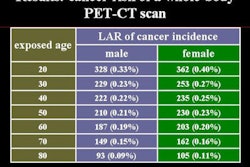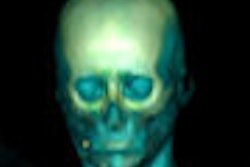Dear AuntMinnie Member,
This week brings a pair of articles on the value of ultrasound contrast media, brought to you in our Ultrasound Digital Community.
Our first story comes from this week's Leading Edge in Diagnostic Ultrasound conference in Atlantic City, NJ, where staff writer Erik L. Ridley is on hand filing daily reports. In one presentation, Austrian researchers reported on their experiences in using contrast-enhanced color Doppler ultrasound to guide prostate biopsies.
They found that ultrasound-guided biopsy enabled them to reduce the number of biopsy cores by detecting small blood vessels and slow blood flow in the prostate. Learn how they did it by clicking here.
In other ultrasound contrast news, clinicians are welcoming the U.S. Food and Drug Administration's (FDA) recent decision to withdraw its requirement that cardiac ultrasound contrast agents carry black box warnings on their labeling. The news is the culmination of a lobbying campaign by echo specialists to convince the FDA that ultrasound contrast is safe, despite a few isolated incidents of patient deaths.
Click here for that story, and check back with the Ultrasound Digital Community at ultrasound.auntminnie.com for further coverage from the meeting.
Medical isotope redux
In other news, staff writer Wayne Forrest examines the controversy that erupted late last week when Canadian government agency Atomic Energy of Canada (AECL) announced that it was shelving plans to build two new nuclear reactors dedicated to producing medical isotopes.
Nuclear medicine advocates had been counting on the new reactors to establish a more stable supply of medical isotopes than that provided by the existing reactor, which began operation in the same year the Soviet Union launched Sputnik (that's 1957, for you history buffs). The precariousness of the situation was highlighted in November 2007 when the AECL reactor was shut down for maintenance -- cutting off North American supplies of key radiopharmaceuticals.
Nuclear medicine experts are examining a number of options, one of which could include the construction of a nuclear reactor in the U.S. dedicated to medical isotope production. But as you can imagine, building new nuclear reactors is neither cheap nor easy -- learn about all the angles by clicking here, or visit our Molecular Imaging Digital Community at molecular.auntminnie.com.
But wait, there's more
As if this weren't enough, learn how the Centers for Medicare and Medicaid Services has begun a process that could lead to federal reimbursement for virtual colonoscopy, and how two of radiology's most prominent academic societies are talking about expanding collaboration -- perhaps as far as a formal merger.




















